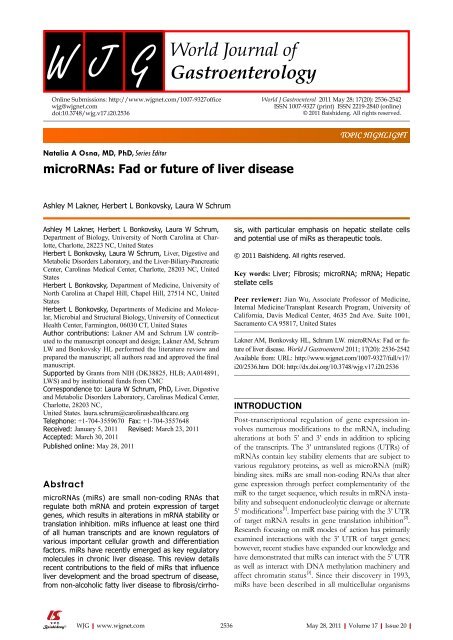20 - World Journal of Gastroenterology
20 - World Journal of Gastroenterology
20 - World Journal of Gastroenterology
You also want an ePaper? Increase the reach of your titles
YUMPU automatically turns print PDFs into web optimized ePapers that Google loves.
Online Submissions: http://www.wjgnet.com/1007-9327<strong>of</strong>fice<br />
wjg@wjgnet.com<br />
doi:10.3748/wjg.v17.i<strong>20</strong>.2536<br />
Natalia A Osna, MD, PhD, Series Editor<br />
microRNAs: Fad or future <strong>of</strong> liver disease<br />
Ashley M Lakner, Herbert L Bonkovsky, Laura W Schrum<br />
Ashley M Lakner, Herbert L Bonkovsky, Laura W Schrum,<br />
Department <strong>of</strong> Biology, University <strong>of</strong> North Carolina at Charlotte,<br />
Charlotte, 28223 NC, United States<br />
Herbert L Bonkovsky, Laura W Schrum, Liver, Digestive and<br />
Metabolic Disorders Laboratory, and the Liver-Biliary-Pancreatic<br />
Center, Carolinas Medical Center, Charlotte, 28<strong>20</strong>3 NC, United<br />
States<br />
Herbert L Bonkovsky, Department <strong>of</strong> Medicine, University <strong>of</strong><br />
North Carolina at Chapel Hill, Chapel Hill, 27514 NC, United<br />
States<br />
Herbert L Bonkovsky, Departments <strong>of</strong> Medicine and Molecular,<br />
Microbial and Structural Biology, University <strong>of</strong> Connecticut<br />
Health Center, Farmington, 06030 CT, United States<br />
Author contributions: Lakner AM and Schrum LW contributed<br />
to the manuscript concept and design; Lakner AM, Schrum<br />
LW and Bonkovsky HL performed the literature review and<br />
prepared the manuscript; all authors read and approved the final<br />
manuscript.<br />
Supported by Grants from NIH (DK38825, HLB; AA014891,<br />
LWS) and by institutional funds from CMC<br />
Correspondence to: Laura W Schrum, PhD, Liver, Digestive<br />
and Metabolic Disorders Laboratory, Carolinas Medical Center,<br />
Charlotte, 28<strong>20</strong>3 NC,<br />
United States. laura.schrum@carolinashealthcare.org<br />
Telephone: +1-704-3559670 Fax: +1-704-3557648<br />
Received: January 5, <strong>20</strong>11 Revised: March 23, <strong>20</strong>11<br />
Accepted: March 30, <strong>20</strong>11<br />
Published online: May 28, <strong>20</strong>11<br />
Abstract<br />
microRNAs (miRs) are small non-coding RNAs that<br />
regulate both mRNA and protein expression <strong>of</strong> target<br />
genes, which results in alterations in mRNA stability or<br />
translation inhibition. miRs influence at least one third<br />
<strong>of</strong> all human transcripts and are known regulators <strong>of</strong><br />
various important cellular growth and differentiation<br />
factors. miRs have recently emerged as key regulatory<br />
molecules in chronic liver disease. This review details<br />
recent contributions to the field <strong>of</strong> miRs that influence<br />
liver development and the broad spectrum <strong>of</strong> disease,<br />
from non-alcoholic fatty liver disease to fibrosis/cirrho-<br />
WJG|www.wjgnet.com<br />
2536<br />
<strong>World</strong> J Gastroenterol <strong>20</strong>11 May 28; 17(<strong>20</strong>): 2536-2542<br />
ISSN 1007-9327 (print) ISSN 2219-2840 (online)<br />
© <strong>20</strong>11 Baishideng. All rights reserved.<br />
TOPIC HIGHLIGHT<br />
sis, with particular emphasis on hepatic stellate cells<br />
and potential use <strong>of</strong> miRs as therapeutic tools.<br />
© <strong>20</strong>11 Baishideng. All rights reserved.<br />
Key words: Liver; Fibrosis; microRNA; mRNA; Hepatic<br />
stellate cells<br />
Peer reviewer: Jian Wu, Associate Pr<strong>of</strong>essor <strong>of</strong> Medicine,<br />
Internal Medicine/Transplant Research Program, University <strong>of</strong><br />
California, Davis Medical Center, 4635 2nd Ave. Suite 1001,<br />
Sacramento CA 95817, United States<br />
Lakner AM, Bonkovsky HL, Schrum LW. microRNAs: Fad or future<br />
<strong>of</strong> liver disease. <strong>World</strong> J Gastroenterol <strong>20</strong>11; 17(<strong>20</strong>): 2536-2542<br />
Available from: URL: http://www.wjgnet.com/1007-9327/full/v17/<br />
i<strong>20</strong>/2536.htm DOI: http://dx.doi.org/10.3748/wjg.v17.i<strong>20</strong>.2536<br />
INTRODUCTION<br />
Post-transcriptional regulation <strong>of</strong> gene expression involves<br />
numerous modifications to the mRNA, including<br />
alterations at both 5’ and 3’ ends in addition to splicing<br />
<strong>of</strong> the transcripts. The 3’ untranslated regions (UTRs) <strong>of</strong><br />
mRNAs contain key stability elements that are subject to<br />
various regulatory proteins, as well as microRNA (miR)<br />
binding sites. miRs are small non-coding RNAs that alter<br />
gene expression through perfect complementarity <strong>of</strong> the<br />
miR to the target sequence, which results in mRNA instability<br />
and subsequent endonucleolytic cleavage or alternate<br />
5’ modifications [1] . Imperfect base pairing with the 3’ UTR<br />
<strong>of</strong> target mRNA results in gene translation inhibition [2] .<br />
Research focusing on miR modes <strong>of</strong> action has primarily<br />
examined interactions with the 3’ UTR <strong>of</strong> target genes;<br />
however, recent studies have expanded our knowledge and<br />
have demonstrated that miRs can interact with the 5’ UTR<br />
as well as interact with DNA methylation machinery and<br />
affect chromatin status [3] . Since their discovery in 1993,<br />
miRs have been described in all multicellular organisms<br />
May 28, <strong>20</strong>11|Volume 17|Issue <strong>20</strong>|

















